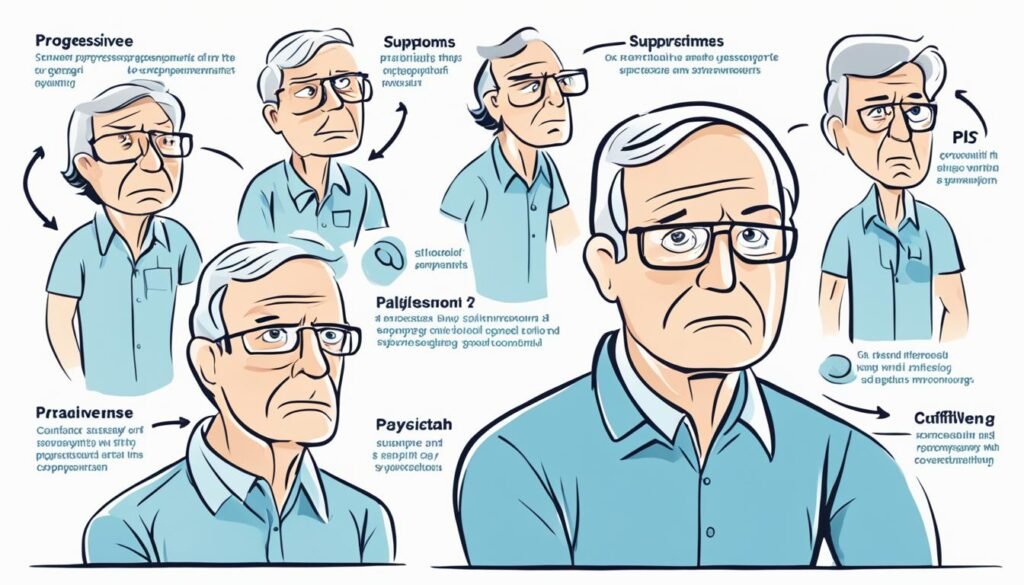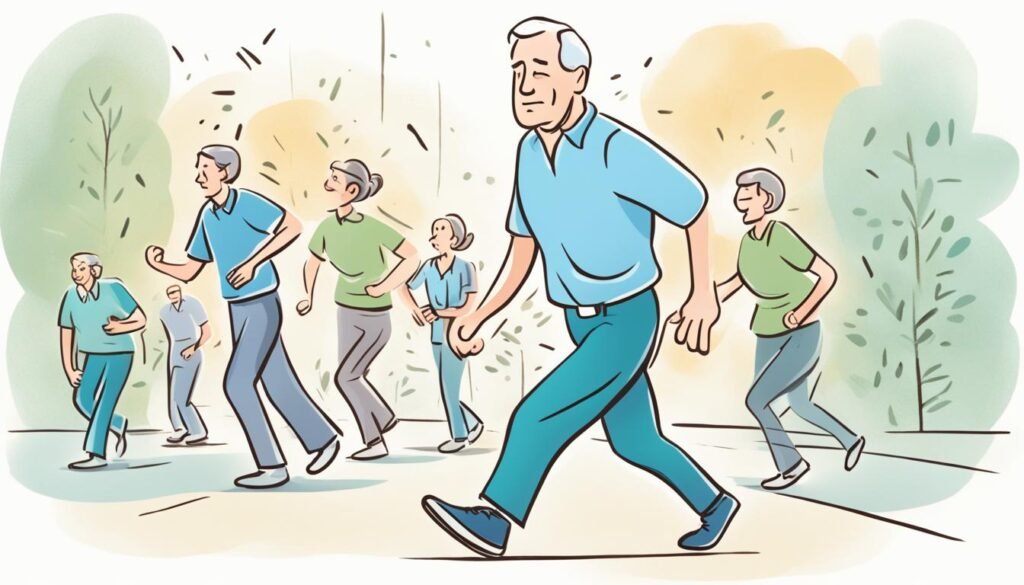Progressive supranuclear palsy (PSP) is a rare and complex brain disorder. It causes problems with balance, eye movement, speech, and swallowing. This disease gets worse over time, making it hard to spot and deal with.
It’s vital to know about the symptoms and treatments. This info is important for those living with PSP and their families. This article will explain everything, from what causes it, how it affects daily life, to the ways to deal with its effects.
Table of Contents
ToggleWhat is Progressive Supranuclear Palsy?
Definition and Overview
Progressive supranuclear palsy (PSP) is a rare brain disorder. It affects movements, balance, and how eyes move. This makes it hard for people with PSP to do daily activities. PSP slowly gets worse over time.
It mainly affects the brain parts controlling eye movements. This leads to problems in seeing things properly. The ‘palsy’ part of the name means muscle weakness or not being able to move well. PSP is also called by its other name, Steele-Richardson-Olszewski syndrome.
Progressive Nature and Impact
PSP gets worse over time, making it a tough condition to live with. This affects how people move, see, talk, and swallow. It slowly takes away a person’s ability to do things on their own.
It’s important to understand that PSP is a progressive condition. This means its effects become more severe over time. Knowing this helps families and caregivers support those with the illness.

Causes of Progressive Supranuclear Palsy
The exact reason behind progressive supranuclear palsy (PSP) is not fully known. Yet, experts think it’s linked to brain cell deterioration in a few key areas. These include the brainstem, cerebral cortex, cerebellum, and basal ganglia. In PSP, a protein known as tau, which normally aids cell structure, misforms. This causes it to gather into clumps, ultimately leading to cell death.
Tau Protein Accumulation
Studies show that in PSP, individuals have too much tau protein in their brain cells. This finding marks tau protein as a possible indicator for the disease. It also opens doors for treatments aimed at this protein buildup, which is crucial in PSP development.
Genetic and Age-Related Factors
PSP does have a genetic side, with some cases appearing to be hereditary. But, such occurrences are rare. Age is also a big player, affecting individuals in their late 60s and 70s mostly. People under 40 very rarely get it. So, age is the main known risk factor for getting PSP.
Symptoms of Progressive Supranuclear Palsy
The symptoms of progressive supranuclear palsy (PSP) can be different for everyone. They usually start quietly and get worse slowly. Trouble with balance and walking is often an early sign, causing falls, mostly backward. Eye problems are also common, like not being able to focus or seeing clearly.
Speech and Swallowing Issues
As PSP advances, people might have more trouble speaking clearly or swallowing. It can make everyday tasks like talking and eating hard. These problems could worsen quality of life if not managed well.
Cognitive and Behavioral Changes
Thinking and behavior can also change with PSP. Memory issues, mood swings, and a lack of interest in activities might happen. Over time, more symptoms like shaking, being overly sensitive to light, and problems making decisions may appear.

It’s key to notice and act on early signs of PSP because it gets worse. Collaborating with healthcare professionals to deal with symptoms can help maintain life quality.
Different Types of Progressive Supranuclear Palsy
Progressive supranuclear palsy (PSP) is a complex condition with different types. Each type has its own set of symptoms and characteristics. The main types are Richardson syndrome and the Parkinson’s disease-like variant (PSP-P).
Richardson Syndrome
Richardson syndrome is the main type of PSP. It causes many problems like trouble with balance and walking. People with this type might talk strangely and have memory issues. Their eye movements, especially looking down, can be hard to control. Falling, especially backward, is common. They might see a slow decline in their physical and mental health.
Parkinson’s Disease-like Variant (PSP-P)
PSP-P looks a lot like Parkinson’s disease but is still different. It has many of the same symptoms as Richardson syndrome. However, in PSP-P, tremors are more common than balance issues. But it still stands out from Parkinson’s disease because of certain features. These are things like eye movement problems and a faster disease progression.

Besides the main types, there are other rarer types of PSP, like corticobasal syndrome and pure akinesia with gait freezing. Knowing the type of PSP someone has is important. It helps doctors choose the best treatments and care for that person.
Diagnosing Progressive Supranuclear Palsy
Diagnosing PSP can be hard at first. The symptoms look a lot like Parkinson’s disease. Doctors look closely at signs like trouble with balance and walking, problems moving the eyes, and issues with speech and swallowing.
Evaluating Symptoms
The healthcare team looks closely at your symptoms. They watch for certain signs of PSP. This includes falling a lot, not being able to move your eyes down, and not getting better with Parkinson’s medications.
This detailed look helps them figure out if it’s PSP or something else. They start to build a clear picture of what’s happening.
Ruling Out Other Conditions
Doctors also try to rule out other illnesses. They check for brain tumors, strokes, or inner ear problems. This might involve tests like MRI or PET scans.
These tests find any brain issues that could be from PSP. They help separate it from diseases that seem similar.

Progressive Supranuclear Palsy Treatment
Currently, there’s no cure for progressive supranuclear palsy treatment. Yet, there are treatments and ways to manage it. These can help ease symptoms and make life better. Your healthcare team will craft a plan just for you, focusing on what you need.
Medications
Medicines used for Parkinson’s, like levodopa, might give a bit of relief for balance and movement issues. But their effects don’t last very long, typically about 2 to 3 years. For most people, these drugs stop being helpful after that.
Assistive Devices
There are special tools to help with PSP challenges. For instance, glasses with special lenses can make looking down easier. And mobility aids, such as walkers or wheelchairs, can boost your safety and stop falls.
Therapy and Exercises
Seeing a physical or occupational therapist can be very helpful. They can work with you on exercises that keep you flexible and well-balanced. Especially as PSP impacts speech and swallowing, speech therapy is key for communicating clearly and eating safely.
Nutritional Support
As swallowing gets harder, you might need a feeding tube for proper nutrition. A dietitian can also help, offering advice on what to eat. They’ll guide you in making dietary changes that keep you healthy.
Regular visits with your medical team are vital. This team includes neurologists, physiotherapists, speech therapists, and more. They help manage PSP’s challenges, ensuring you can live the best life possible for as long as you can.

Complications of Progressive Supranuclear Palsy
Progressive supranuclear palsy (PSP) could lead to serious complications if not addressed. Difficulty swallowing is a major concern. It can lead to choking and food entering the lungs. These problems may lead to pneumonia.
Choking and Aspiration
Swallowing issues with PSP can become severe. They can cause choking and food going into the lungs. This risk grows as the disease weakens the swallowing muscles.
Fall and Injury Risks
People with PSP often face balance and coordination problems. These can lead to falls, increasing the chances of injuries like head trauma and fractures.
Backing up and falling is quite common for them. This makes the use of tools and careful monitoring key to avoid accidents. Specialized care is essential to manage these risks.

Coping with Progressive Supranuclear Palsy
Living with progressive supranuclear palsy (PSP) is hard for those diagnosed and their caregivers. However, there are many ways and resources to help cope with this condition’s challenges.
Symptom Management Strategies
One way to deal with PSP is using devices like walkers or wheelchairs. These can make moving around easier and lessen the risk of falls. Also, speech therapy and exercises for swallowing can help with communication and eating problems. These steps can maintain your independence and improve life quality.
Support Resources
It’s also key to find support resources, such as support groups and occupational therapy. And, palliative care can offer both physical and emotional support. Being part of a support group can let you meet people facing the same struggles. Plus, occupational therapy and palliative care help tailor support to meet your specific needs.
By using multiple care strategies and reaching out to available help, it’s possible to enhance life quality and independence with progressive supranuclear palsy.
progressive supranuclear palsy Prognosis
Progressive supranuclear palsy (PSP) is a long-term illness that gets worse with time. Sadly, there is no cure for it. For people with PSP, the future looks challenging. This is because the symptoms get worse, making life harder. People with this illness might not be able to do things they used to.
People with PSP usually live between 5 to 7 years after they’re diagnosed. But some might live longer. How fast the illness moves can vary. The type of PSP, when it started, and other health issues affect this. As time passes, life quality drops. Some may die because of lung problems like pneumonia.
Living with Progressive Supranuclear Palsy
Living with PSP is challenging. It affects many parts of your daily life. You might find it hard to keep your balance or move around. This makes simple tasks tough and can reduce your independence.
Vision issues are common. You may not be able to focus well or look downwards. This can affect how well you can read or drive. Problems with speech and swallowing can also make eating and talking harder.
Then there are changes in your thinking and mood. Memory problems and mood swings can influence how you interact with others. All of this adds up, making life much more difficult.
Daily Challenges
As PSP gets worse, you’ll need more help. It becomes harder to do daily tasks. Life with PSP can be tiring and stressful for you and your family.
Staying independent and enjoying life takes work. You need to use many different strategies and get the right help. This is how you face PSP with strength.
Caregiver Support
For help, look into things like occupational therapy and support groups. Finding a bit of relief through respite care can also be important for everyone.
Caregivers carry a big load. They, too, need support. When you work closely with your healthcare team and others, you help not just yourself but also those who care for you. Together, you can make living with PSP a bit easier.
Research on Progressive Supranuclear Palsy
Scientists are hard at work, trying to understand more about progressive supranuclear palsy (PSP). They want to find new ways to treat it. They’re looking into the tau protein’s part in PSP, as well as what genes and the environment could do to PSP. Also, they’re using special imaging to help spot PSP early on.
Ongoing Studies
Researchers are look into how gene changes can lead to PSP. They are also trying to stop the tau protein from getting worse in PSP patients. Besides, they’re checking if stem cells could help with PSP symptoms. The Rare Diseases Clinical Research Network is part of this. They are studying neurological diseases, including PSP, to learn more and better handle it.
Potential Treatments
So far, there is no cure for PSP. But, ongoing studies hope to find better ways to deal with it. This research wants to improve how we treat the disease. And it aims to make life better for those fighting this rare brain disorder. There are clinical tests to join for PSP patients. These trials are changing how people care for PSP and connect patients with new care options.
Progressive Supranuclear Palsy Statistics
Progressive supranuclear palsy (PSP) is pretty rare, with about 5 to 6.5 cases per 100,000 in the U.S. each year. There’s around 1 new case per 100,000 people yearly. Men are more likely to get PSP than women. Most who get it are in their late 60s or 70s, but it almost never happens before the age of 40.
This disease is not easy to spot. Its early signs often look like other brain problems, making it hard to diagnose correctly. But, doctors and researchers are working hard to change this. They are spreading the word about PSP to help diagnosis and understand how many people it affects.
Raising Awareness of Progressive Supranuclear Palsy
Raising awareness about progressive supranuclear palsy (PSP) is super important. It’s not well-known yet affects many people. Groups like CurePSP teach the public and doctors about PSP. They aim to raise awareness and provide help for those with the disease.
Advocacy Groups
Advocacy organizations educate about PSP’s signs, causes, and treatments. They work to make it easier to diagnose PSP early. This ensures people with PSP get the care they need. By working with doctors and talking to the public, these groups also fight the shame around PSP. They empower those with PSP to speak up for their needs and find support.
Spreading Knowledge
Raising awareness through campaigns and special projects is key. It helps people understand PSP better. This includes both the public and those who work in healthcare. These efforts push for more research and resources for PSP. They make sure people with this condition get the help and attention they deserve.
Conclusion
Progressive supranuclear palsy (PSP) is a rare but severe brain illness. It greatly changes the lives of those with it and their families. Brain cells slowly break down, leading to varied symptoms that make daily life hard.
Although there is no cure yet, research and new treatments bring hope. They aim to make life better for those coping with PSP.
We can help by spreading the word, building support groups, and asking for more help and money. This way, we learn more and find better ways to help people with this condition. Teamwork and kindness are key to giving care and support to both patients and their families. This helps them live better and feel more independent.
As we keep learning and looking for new answers, our support remains vital. By staying involved and working together, we can fight PSP effectively. This can lead to a better life for everyone touched by this disease.
FAQ
What is progressive supranuclear palsy?
What causes progressive supranuclear palsy?
What are the symptoms of progressive supranuclear palsy?
Are there different types of progressive supranuclear palsy?
How is progressive supranuclear palsy diagnosed?
What are the treatment options for progressive supranuclear palsy?
What are the potential complications of progressive supranuclear palsy?
How can individuals with progressive supranuclear palsy cope with the condition?
What is the prognosis for individuals with progressive supranuclear palsy?
What is the current state of research on progressive supranuclear palsy?
Source Links
- https://www.mayoclinic.org/diseases-conditions/progressive-supranuclear-palsy/symptoms-causes/syc-20355659
- https://www.ninds.nih.gov/health-information/disorders/progressive-supranuclear-palsy-psp
- https://www.hopkinsmedicine.org/health/conditions-and-diseases/progressive-supranuclear-palsy
- https://www.ncbi.nlm.nih.gov/pmc/articles/PMC8061531/
- https://www.psp.org/iwanttolearn/progressive-supranuclear-palsy
- https://www.ncbi.nlm.nih.gov/pmc/articles/PMC8864174/
- https://www.nhs.uk/conditions/progressive-supranuclear-palsy-psp/diagnosis/
- https://www.mayoclinic.org/diseases-conditions/progressive-supranuclear-palsy/diagnosis-treatment/drc-20355664
- https://www.nhs.uk/conditions/progressive-supranuclear-palsy-psp/treatment/
- https://www.ncbi.nlm.nih.gov/pmc/articles/PMC8461411/
- https://www.ncbi.nlm.nih.gov/pmc/articles/PMC9837348/
- https://www.ncbi.nlm.nih.gov/pmc/articles/PMC9496895/
- https://rarediseases.org/rare-diseases/progressive-supranuclear-palsy/
- https://wexton.house.gov/news/documentsingle.aspx?DocumentID=932

Best Neurologist Doctor In Patna: Dr Chandril Chugh Dedicated to Your Well-being
Dr.Chandril Chugh is a neurologist who trained and practiced in the USA for more than a decade. He is compassionate and caring and is most well known for being a patient listener and spending ample time with patients.
